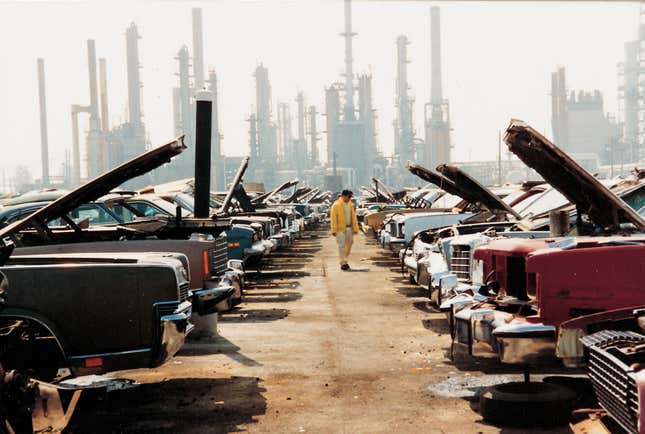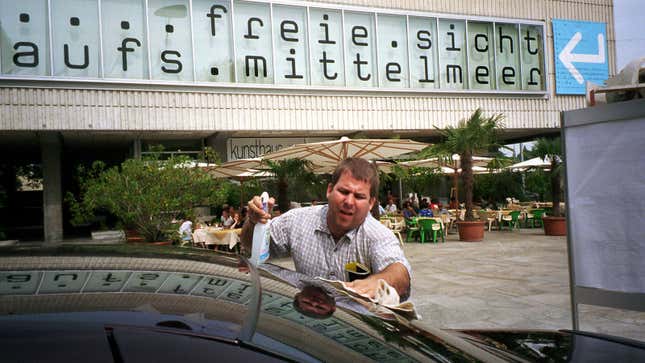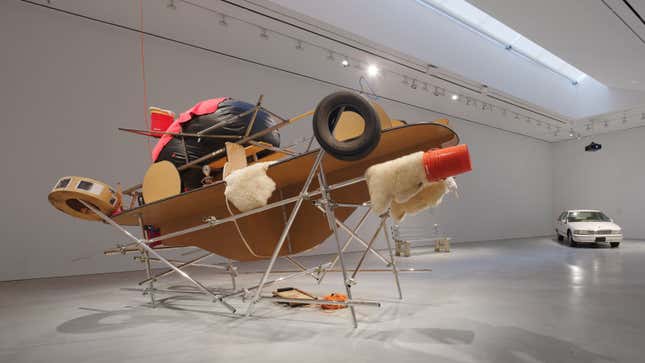The opposite day, as I left an incredible present of late Jacob Lawrence works at the DC Moore Gallery in Manhattan, I spied one thing odd on the artwork gallery throughout the road: a yellow Fiero. Figuring out a bit an excessive amount of about the historical past of America’s first mid-engine manufacturing automotive, I instantly seen one thing was flawed. First, it was a notchback 1984 mannequin and yellow was solely accessible on this mannequin in 1988. Second, the colour was too lemon creamy to be an unique talbot yellow automotive. Intrigued, I went inside.
Because it occurred, almost the complete Hauser & Wirth gallery on New York’s West twenty second Avenue was given over to automobiles. I instantly acknowledged the artwork because the work of Jason Rhoades, a rising star who died of coronary heart failure abruptly on the age of 41 in 2006, who was recognized for his inventive affection for the car.
“For Jason, the automotive was a car for making artwork and form of creating new sculptures,” Ingrid Schaffner, the senior curatorial director at H&W, tells me from LA a couple of days after I seen the present.

Rhoades was into automobiles as metaphors, based on Schaffner. His ultimate MFA undertaking at UCLA concerned racing a small pretend Ferrari round a cardboard monitor whereas sporting a racing go well with of his personal design, a means of demonstrating “competitors and his plan to go away artwork faculty a winner,” she says. His work racing mini-bikes across the cement mattress of a drained amusement park monkey island was, based on Schaffner, about “experiencing the velocity of camaraderie.” His miniature automotive race at Willow Springs, the place car-mounted-cameras captured images of the drivers that he printed and hooked up to the autos in the course of the race, was, Schaffner says, about “the automotive as a type of image-making machine.”
The 5 autos on this New York exhibit had all had roles in different Rhoades artwork initiatives. The Fiero had been a part of Rhoades’ 1994 ersatz Ikea set up “Swedish Erotica and Fiero Elements,” explaining its delicate Swedish yellow palette. He reworked a white French 1989 Liger Optima micro-car into an intimate social house for his 1997 set up “Dialog Automotive.” A burgundy 1996 Impala SS had been parked within the plaza of the Kunsthaus in Zurich, Switzerland for his 1998 piece “Worldwide Museum Challenge about Leaving and Arriving.” A white ex-law enforcement 1992 Chevrolet Caprice Traditional had been a part of a French exhibition in 1996 referred to as “Site visitors.” Then, there was the blue 1989 Ferrari 328 GTS.

This Italian unique was associated to the Caprice in a means solely potential within the artwork world. Having displayed the Chevy in Bordeaux as an artwork object, and retained possession of it, Rhoades advised a notable collector of his work that it was now very priceless, as priceless because the collector’s blu chiaro metallic Ferrari. Rhoades urged a commerce, and the collector agreed. “However as a result of he lived in Switzerland,” Schaffner says, “the collector stated, ‘you may preserve the Caprice.’”
Being very aggressive, and an Angeleno — the place you might be what you drive — Rhoades was seduced by the Ferrari and the standing it conferred. “He stated that the Ferrari is a car for ambition,” Schaffneer says. “When you present as much as a gap within the Ferrari, and your whole friends are driving beat-up pickup vehicles, your status is subsequent degree.”
Rhoades’ car-as-art factor isn’t easy hucksterism. The auto has been acknowledged as a sculptural artwork kind for the reason that earliest days of the Modernist motion, incomes revered locations within the everlasting assortment of establishments just like the Museum of Trendy Artwork, and being exhibited in effective artwork museums all through the nation and around the globe. Artwork historians even theorize that the car’s potential to ship particular person entry to a imaginative and prescient of the world at velocity within the early twentieth century was one of many core influences on early Trendy artwork actions like Cubism and Futurism, which portrayed topics concurrently from diverse views. And the displaying of mass-produced objects as artwork has historic precedent in Dadaist pioneer Marcel Duchamp’s concepts of the Readymade, which elevated abnormal client items to inventive standing, breaking down boundaries and ushering in concepts of “conceptual” artwork.

Rhoades is clearly quoting from and riffing on these concepts. “Jason is type of taking part in Duchamp at his personal recreation. If Duchamp goes to make a urinal right into a Readymade sculpture. Jason’s going to take the automotive and make it right into a Readymade sculpture,” Schaffner says. However most attention-grabbing on this was Rhoades’ codified notions of how an car could make this transformation. It requires greater than merely inserting it in a gallery, on a plinth. “For Jason, the automotive was a car for making artwork and creating new initiatives. After which when the undertaking ended, the automotive stopped, and it turned a sculpture in itself,” Schaffner says. “These 5 automobiles, they’ve all achieved their work, and every have their very own discrete initiatives. And now, they’ve develop into sculptures in their very own proper.” Amen.
After all, we couldn’t resist asking if any of the automobiles nonetheless run. Sadly, they don’t. All of them got here to New York on lined trailers and needed to be rolled into place like some other sculpture. “To exhibit them in a gallery, it’s a must to drain all their fluids,” Schaffner says. “You don’t need them leaking or exploding.”

True. Although that may make for an thrilling subsequent chapter of their ongoing inventive life.
Try Jason Rhoades’ “Drive II”
Hauser & Wirth
542 West twenty second Avenue
New York, NY 10011


